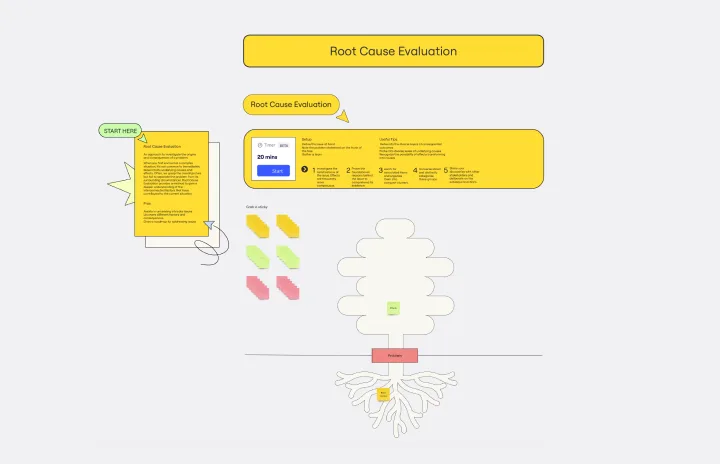About the 5 Whys Templates Collection
The 5 Whys is a powerful problem-solving tool used to identify the root cause of an issue by asking "why" five times. This technique is essential in business for uncovering the underlying causes of problems, enabling teams to implement effective solutions and prevent recurrence. Miro's 5 Whys templates collection offers a structured approach to this method, making it accessible and easy to use for professionals at any level.
Why you'll love the 5 whys templates
Using Miro's 5 Whys templates provides several benefits:
Structured problem-solving: The templates guide you through each step of the 5 Whys process, ensuring a thorough analysis.
Collaboration: Miro's collaborative platform allows team members to contribute in real time, fostering a collective approach to problem-solving.
Visualization: The templates help visualize the problem and its root causes, making it easier to understand and communicate findings.
Efficiency: By providing a ready-made framework, the templates save time and ensure consistency in the problem-solving process.
Flexibility: The templates can be customized to fit the specific needs of your team or project.
Sticky notes: Use sticky notes for quick brainstorming and organizing information visually.
Miro AI for Insights: Leverage Miro AI to gain deeper insights and streamline the analysis process.
How to use the 5 whys templates in Miro
Access the template: Start by choosing one of the 5 Whys template on Miro's template library.
Define the problem: Clearly state the problem you are trying to solve at the top of the template.
Ask the first why: Write down the first "why" question related to the problem and answer it.
Repeat the process: Continue asking "why" for each subsequent answer until you have asked five times. Each answer should lead you closer to the root cause.
Analyze the root cause: Once you have identified the root cause, discuss potential solutions with your team.
Implement solutions: Develop an action plan to address the root cause and prevent the problem from recurring.
Miro's 5 Whys templates are a valuable tool for any team looking to improve their problem-solving capabilities. By providing a structured, collaborative, and visual approach, these templates help teams identify root causes and implement effective solutions, ultimately driving better business outcomes.
5 Whys template example
Let's say you're trying to ship an app that your team has been working on. You were prepared to ship on time, but you ended up delivering the app two days overdue.
Here's how you might use the 5 Whys template to uncover the reason that happened and how you can avoid delays in the future.
Step 1: Start with the broadest possible question, then try to answer it.
Example: Why was the app late? It was late because there was a production delay.
Step 2: Based on this answer, you can narrow the question slightly.
Example: Why was there a production delay? There was a production delay because the engineering team had to deploy a last-minute patch, which the product team did not know about until launch day.
Step 3: Narrow the question even further, and then answer it.
Example: Why didn't the product team know about the patch? The product team didn't know about the patch because engineering didn't communicate it to them.
Step 4: Keep narrowing and answering the question.
Example: Why didn't the engineering team communicate to the product team? The engineering team didn't communicate with the product team because they did not know how to communicate that information.
Step 5: Ask the question one last time to zero in on your solution.
Example: Why didn't the engineering team know how to communicate with the product team? The engineering team didn't know how to communicate with the product team because the product team had no clear point of contact or processes for communication.










